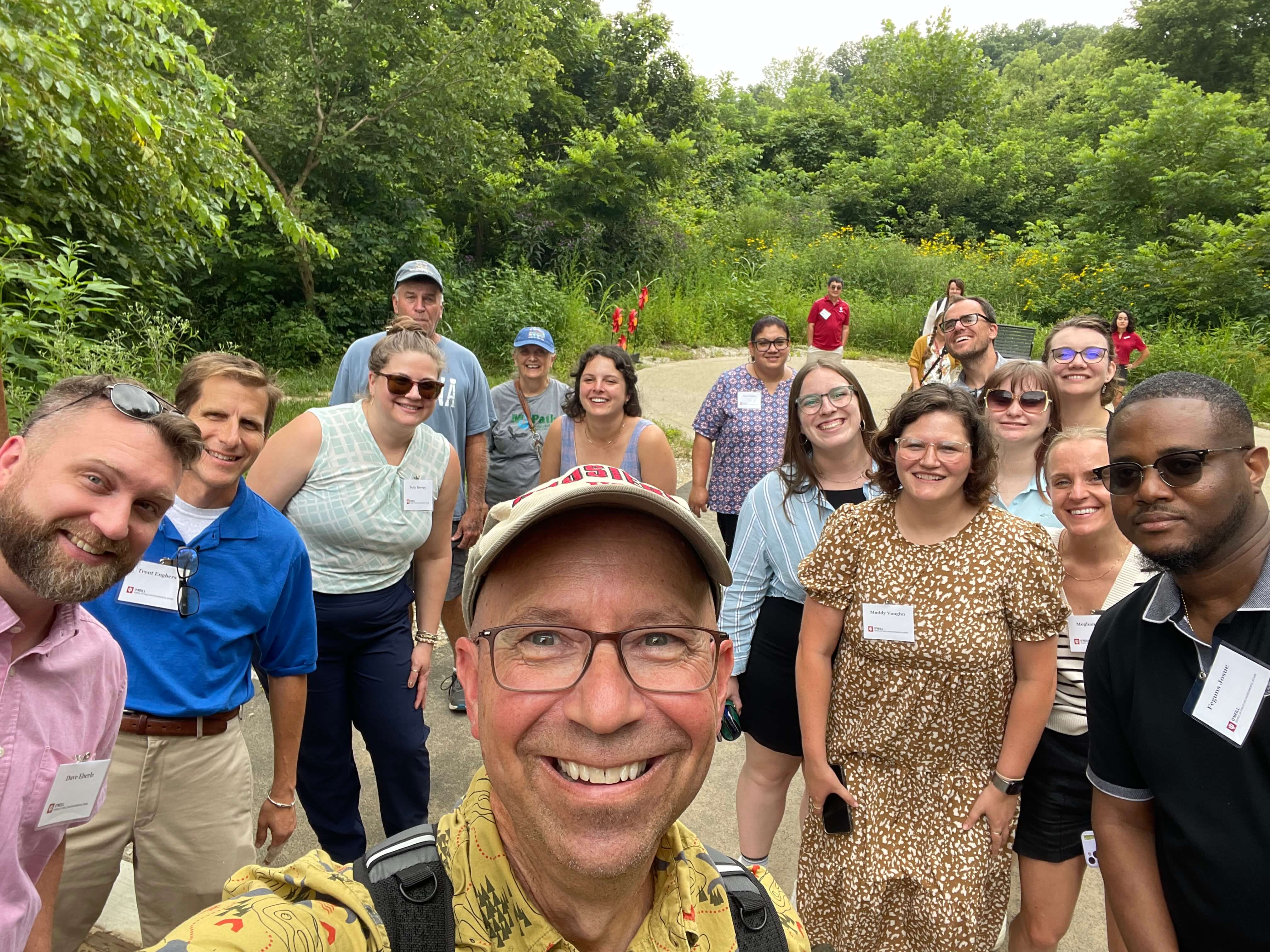The U.S. Environmental Protection Agency (EPA) hosted a presentation and open house last month to share updates on the remedial investigation for the Franklin Street Groundwater Superfund Site.
The meeting was called to share where the EPA is in the Superfund process, what sampling has been completed, what sampling work is planned for the rest of 2025, and what the long-term schedule for the site is.
As reported in April 2024 by The Owen News, the site was added to the National Priorities List in May of 2018, but the next step in site milestones, the remedial investigation, did not begin until the fall of 2023. Site testing began in early 2024.
The contaminant tetrachloroethene (PCE) was first detected by the BBP Water Corporation in 2011 and has been completely removed from the treated water since 2017. Even at the initial detection, the contaminant's levels were 1.2 parts per billion (ppb), which is under the maximum contaminant level set by the EPA at 5 ppb.
PCE is also sometimes referred to as PERC.
According to the National Institutes of Health (NIH), PCE “is a manufactured chemical that is widely used for dry cleaning of fabrics and for metal-degreasing,” and “it appears as a clear colorless volatile liquid.”
PCE is both a known and probable carcinogen, and it can harm the nervous system.
PCE is also a volatile organic compound. It can contaminate drinking water, indoor air quality through soil vapor intrusion, and groundwater.
“We’re the ones that found the problem in the first place because we do annual water testing,” BBP CEO Todd Gardner told The Owen News last spring.
“Even though the finished water was under the guidelines set for the chemical [PCE], the BBP Water Corporation Board of Directors decided to be proactive, and in 2014 designs for treating and removal of all PERC from the finished water was being engineered,” BBP’s 2022 annual water quality report said.
In addition to a new well being added, BBP added air strippers and reverse osmosis filtering units.
PCE has not been found in BBP’s finished water since the air strippers were turned on in May of 2017, completely removing it from the finished water.
“Even before then, we weren’t using the well that had the contamination, so we never sent treated water that was contaminated. It was a well that wasn’t being used at the time that it popped up on,” Gardner told The Owen News last spring.
“We are proud to report that the water quality provided by BBP Water Corporation has met or exceeded the water quality standards established at the state and federal levels,” the report reads. “The BBP Water Corporation Board of Directors are all members of the water system. Our customers are our neighbors and relatives. BBP strives to produce the safest water possible for our customers.”
The EPA has completed several sampling activities over the past year.
Soil vapor plume delineation took place during February and March of 2024. With the rapid soil vapor plume delineation, 63 exterior soil vapor locations in city rights-of-way were analyzed with HAPSITE. Seven locations exceeded the EPA residential soil Vapor Intrusion Screening Levels (VISLs) for PCE, and four soil vapor plumes were established based on PCE exceedances.
Potential source area soil sampling took place from March to September of last year.
The EPA tests for vapor intrusion sampling in both the spring and the winter. The results may be different based on the season. Not only can the season impact the soil moisture and groundwater levels which influence the movement and concentration of vapors in the soil, heating and cooling systems can change the rate at which soil vapors enter the building. Because of this, winter is typically the worst-case scenario as homes tend to be more closed up than in the summer when windows might be open.
“If there’s going to be a worst-case result, it’s going to be in the winter,” said Dion Novak, EPA remedial project manager for EPA-Region 5. Novak gave the presentation and answered questions following the presentation.
All testing requires the permission of the property owner, and the results from individual properties are not published. Rather, locations are placed on a map.
As part of the process, should a testing site have an issue with the air quality, the EPA will install a mitigation system at no cost to the owner. It is similar to how radon is removed from homes.
The mitigation system creates negative pressure below the structure to essentially blow the vapors outside where it dissipates and is no longer a concern.
Breathing in the vapors from PCE poses similar health risks as consuming it.
Residential and commercial vapor intrusion sampling took place in April, May and August of 2024 and January and March of 2025. The initial properties for sampling were identified based on the results of the HAPSITE investigation. A total of 49 properties were sampled during the vapor intrusion sampling conducted in 2024 during the cooling season. Of those properties, there were 54 sub-slab soil vapor samples, 34 crawl space air samples, 91 indoor air samples, and 24 outdoor air samples. For the heating season samples, which were all taken in 2025, 39 properties that were originally sampled during the 2024 cooling season were resampled. This included 48 sub-slab soil vapor samples, two exterior soil vapor samples, 22 crawl space air samples, 72 indoor air samples, and 18 outdoor air samples. Three properties refused access for a second round of sampling, and seven properties were unresponsive to scheduling attempts.
Through the soil vapor intrusion during the cooling season, additional properties were identified based on those results. An additional 26 previously untested properties were sampled for the first time in March 2025. Testing for those 26 properties included 24 sub-slab soil vapor samples, four exterior soil vapor samples, 12 crawl space air samples, 46 indoor air samples, and 12 outdoor air samples.
“We’ve got close to 100 properties that we have tested since spring of last year,” Novak said. “We’re trying to be as thorough as we can be to give you the best information so at the end I can say here’s what the problem is, here’s what we’re going to do to fix it.”
VISLs set by the EPA are calculated at minimum levels to protect the most sensitive individuals from potential future health effects. The EPA specifically notes that exceedances in the VISLs do not necessarily mean there is a health risk.
From March to September of last year, a total of 30 soil borings were advanced and 206 soil samples were collected. These soil samples were collected from six potential source properties and analyzed for volatile organic compounds (VOCs); semi-volatile organic compounds (SVOCs); 1,4-dioxane; polychlorinated biphenyls (PCBs); metals; and per- and polyfluoroalkyl substances (PFAS).
Initial piezometer installations also took place from March to September of last year. The EPA installed 21 groundwater piezometers during that time. The EPA also began a townwide groundwater study in June. That study is ongoing. They collected groundwater samples from 18 EPA-installed piezometers and 18 existing wells.
Initial monitoring well and piezometer sampling took place in May and June of 2024, and groundwater hydraulic profiling began in June of 2024 and is ongoing. The EPA also collected 70 groundwater samples from 20 temporary borings.
Groundwater samples were initially analyzed for VOCs; SVOCs; 1,4-dioxane; PCBs; metals; PFAS; and some for only VOCs.
“Obviously just like all the other levels that EPA uses, they’re designed to be protective of human health and calculated to prevent and to protect even the most sensitive people from potential future health effects. Just because you have results and it exceeds some of these screening numbers, it doesn’t mean there’s a health risk. It just gives us enough information, again, to be as complete and as thorough as possible,” Novak said.
Novak then presented what the immediate and long-term next steps are for the remedial investigation. The EPA will continue the groundwater study and install groundwater monitoring wells through April and May of 2025 and begin quarterly groundwater sampling. They are also doing a potable well survey to try to identify all potable wells within five miles of the site and sample potable wells in areas of potential site-impacted groundwater.
They will also continue round two residential and commercial vapor intrusion sampling for the additional properties tested in March 2025. These will be tested in August.
The EPA is also completing an underground sewer investigation by utilizing 25 utility access locations for sewer gas sampling this summer. They will be prioritizing areas based on the results of other testing.
Further into 2025 and 2026, they will do surface water and sediment sampling. If necessary, White River sampling will take place in 2026. That need will be based on the likelihood that groundwater may be discharging into the river.
“As you can see, we’ve done a lot of work. We still have a lot of work yet to do,” Novak said.
One resident said that they felt some locals might not self-report wells because of the misconception that any well contamination would shut down their well and force them onto BBP or city water.
Novak reiterated that all testing is done with the property owner’s permission. He said wells could also be identified by BBP, the state board of health, and DNR records.
“The main way to be at risk from this type of contamination is to have a private well that’s potentially impacted, and so if you’re drinking that water I want to know that. And if there’s chemicals in there that you shouldn’t be drinking, I will tell you. I can’t mandate that you switch to city water,” Novak said. “I can tell them here’s why you should do it, here’s the risks and all that, but again if they say no, I can’t force them.”
He then addressed some of the solutions to contaminated groundwater.
“There’s a number of ways that we can fix contaminated groundwater. We can pull it out of the ground and treat it and then discharge it. We can do that. We can treat it under the ground, with good chemicals that'll actually break down that contamination. For a private well that is contaminated, obviously, the solution is to close the well and to hook them up to some other alternative water source,” Novak said.
He said it is difficult to come back and do testing later for a property owner that changes their mind because it is no longer part of their investigation.
Another resident asked if untreated, contaminated wells could contaminate a treated or uncontaminated well nearby.
“I'm not going to say no, it will never happen, but typically with this, how groundwater gets from here to there is relatively unimpacted by a private well because you're not pulling enough water out of the ground to kind of change the direction of the water,” Novak said. “Now, if you're an industrial well pulling thousands of gallons out of the ground, that's a different story. But a private well, you're only taking out what you need, right? And it's typically a very small amount.”
Novak ended the presentation with several thank yous. The first was to the Spencer Wastewater Treatment Plant for allowing them to store equipment on the property and discharge drilling water directly after testing. This results in significant government cost savings. The next was to the residents that “have been extremely nice.” He noted that the field teams feel very welcome. He also noted that the field team also really enjoys the local restaurants in Spencer.
The same presentation was presented again later in the evening. The Owen News was not able to send a reporter due to coverage of another conflicting meeting. The slides can be viewed on the web page dedicated to the Franklin Street Groundwater Superfund Site on the EPA website.




